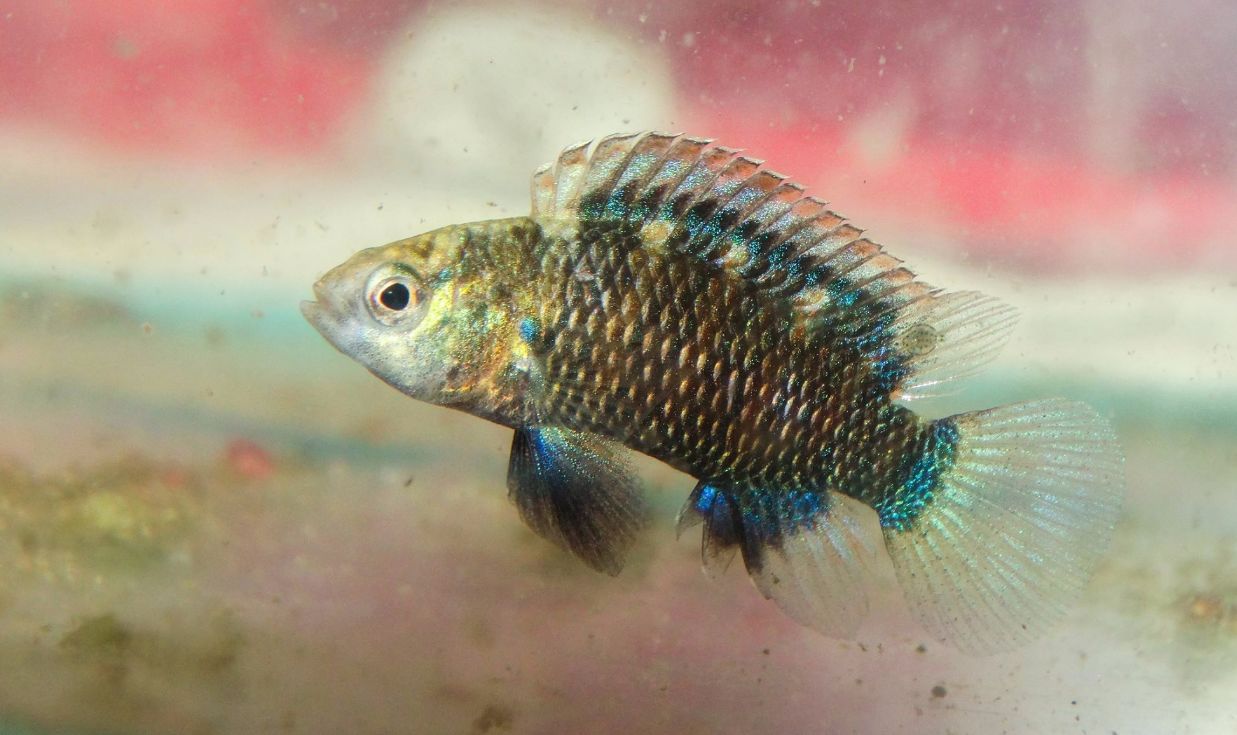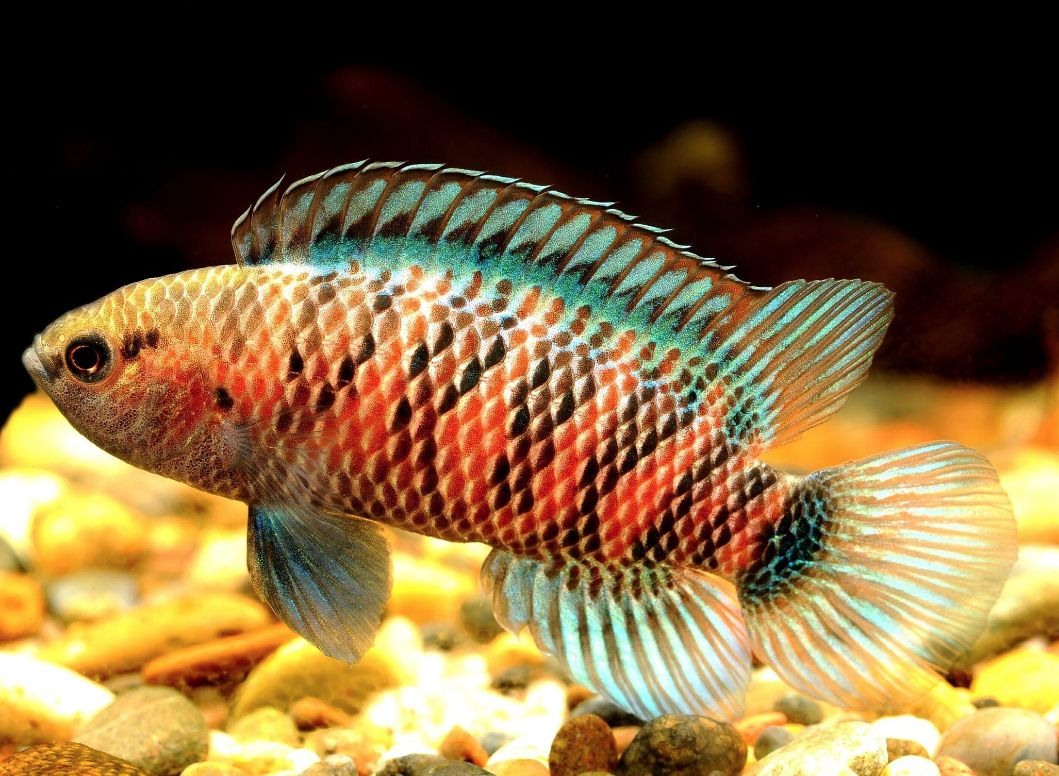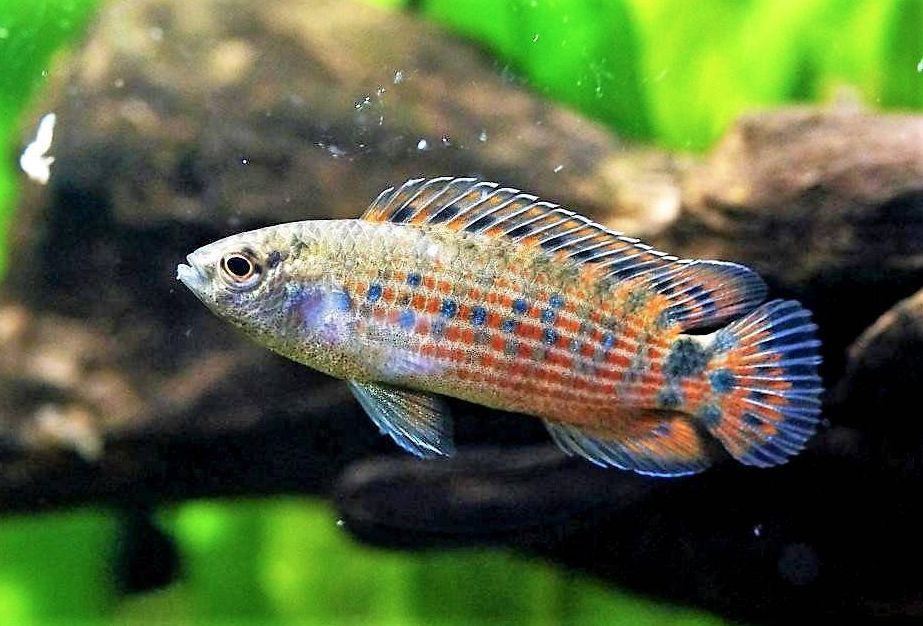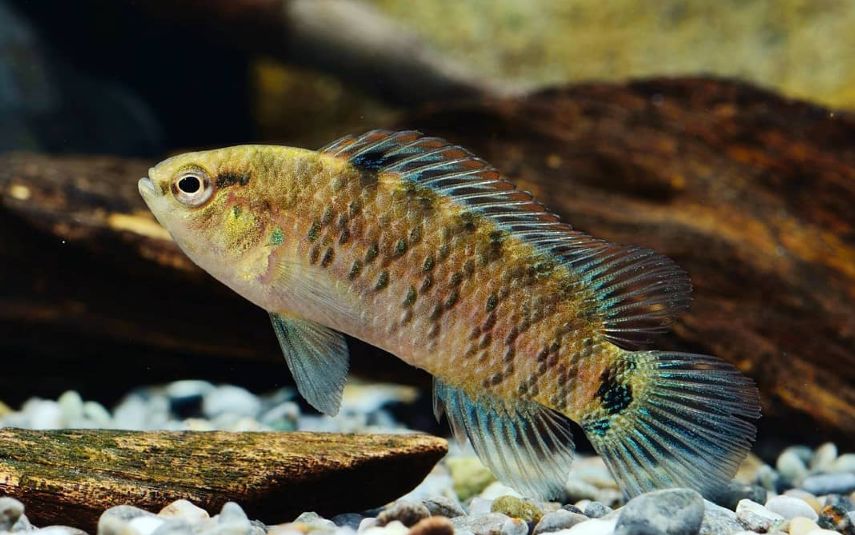Badis badis (also known as the blue badis or dwarf chameleon fish) is the most famous Badis genus and Badidae family representative. This is a good-looking dark-blue fish that has been popular among aquarists for several dozens of years already. This calm, not demanding in terms of keeping fish, can be interesting not only for experts but for beginning aquarists as well. The Badis is popular among aquarium enthusiasts due to its vibrant coloration and interesting behavior.

Contents
Habitat in the wild
For quite a long time, it has been considered that badis badis habitat is limited to waters of Central and South India. However, the studies held during the last ten years had broadened their habitat significantly and included lentic waters in South India, Nepal, and Bangladesh (Ganges River basin).
The species is also encountered in Pakistan, India state Himachal Pradesh (Yamuna basin), Mahanadi River basin (India state Chhattisgarh), Bhutan, India state Assam (Kaziranga River, Gauhati River, Dibru River).
Badis badis was brought to Europe at the beginning of the last century. German aquarists were the first Europeans to see the badis badis fish. Soon it was successfully bred by them and formed a stable aquarium population.
In the wild, the badis badis inhabits lentic or slowly flowing waters. In general, badis badis natural biotope has a low water level, lots of vegetation, and snags. In the wild, Badis badis can be found in areas with dense vegetation, submerged roots, and fallen branches. They prefer habitats with plenty of hiding places, as they are naturally shy and seek cover to feel secure. Aquatic plants, floating vegetation, and submerged structures provide them with suitable hiding spots and areas to explore.
A small river in West Bengal, which in some areas can be wade through easily, can be an example of such a biotope. It has a slow water flow with the following water parameters: temperature from 72-79°F (22-26°C), pH 6,4, GH 6°. These fish are typically found in areas with soft to moderately hard water.
Overall, the habitat of Badis badis consists of calm freshwater environments with ample vegetation and suitable water parameters. When setting up an aquarium for Badis badis, replicating these conditions as closely as possible will contribute to their well-being and help them thrive in captivity.

Description
Based on the latest revision, about 14 Badis kinds have scientific description nowadays. It seems that those described kinds are just a small part of the whole genus. Each year some new not described species appear. Considering that the genus has a wide areal, which becomes more accessible, more discoveries may be expected in the nearest future. Badis badis is the most famous genus representative, while scarlet badis comes second in this list.
The badis badis fish resembles dwarf cichlids in its appearance. The body is comparatively low, elongated and a bit flattened from the sides. The dorsal is long, and the caudal fin is rounded. It has a small head and mouth.
The body coloring is quite unstable and changeable. It depends on tank conditions, the physiological state of the fish, and its mood. It is especially true for males. In several seconds their coloring may change unrecognizably. Usually male Badis badis have a deep blue or greenish-blue body coloration, which is adorned with vertical dark stripes. The scales of the male fish are iridescent, shimmering in different shades under light. Exited males coloring when they have fights between them or during the spawning period look especially good. The female badis badis fish body has significantly simpler coloring with brown colors prevailing.
The male is about 3 inches long (7-8 cm), while females are 2 inches (4.5-5 cm) long. In the tank, the fish grows a bit smaller. This size range is typical for adult Badis badis individuals. However, it’s important to note that individual fish sizes can vary, and some specimens may be slightly smaller or larger than the average range. Factors such as genetics, diet, and environmental conditions can influence the growth and size of the fish.
| Characteristic | Description |
|---|---|
| Common Name | Badis, Blue Perch, dwarf chameleon fish |
| Scientific Name | Badis badis |
| Family | Badidae |
| Size | Approximately 2-3 inches (5-8 cm) in length |
| Body Coloration | Males: Deep blue or greenish-blue with vertical dark stripes and iridescent scales. Females: Paler coloration |
| Behavior | Peaceful and somewhat shy |
| Habitat | Freshwater rivers, streams, and slow-moving bodies of water in South Asia |
| Preferred Water Parameters | Temperature: 72-79°F (22-26°C), pH: 6.0-7.5, soft to moderately hard water |
| Diet | Carnivorous; small invertebrates, insects, zooplankton. In aquariums, can be fed high-quality pellets, frozen or live foods like bloodworms, brine shrimp, and small crustaceans |
| Breeding | Males exhibit vibrant colors during courtship, build bubble nests, females lay a small number of eggs, fry can be fed infusoria or tiny live foods |
| Compatibility | Generally peaceful, suitable tank mates include small, peaceful fish occupying different levels of the tank, such as rasboras, small tetras, or peaceful dwarf cichlids |

Keeping in the tank
Badis badis is quite not demanding, and it gets used to any tank conditions quickly. Let’s keep in mind that the badis badis fish species usually come from the wild; thus, it’d be logical to keep tank water parameters like those peculiar to the natural biotopes, at least at first.
Water parameters
The water hardness can be within 5-12° dGH, pH slightly acidic to neutral, within 6.0-7.5, water temperature in the range 72-79°F (22-26°C). In most natural waters, pH level is about 7 or a bit less, and water hardness is in the range of 3-4 dGH. In aquarium recommended to maintain a general hardness (GH) level between 5-12 dGH for these fish.
The latter are the parameters you should try to reach only when breeding the species. Badis badis can also breed in ordinary tap water with pH not higher than 7.5 and hardness not higher than 8 dGH.
It’s recommended to renew part of the tank water once or twice a week. It’d be better if the fresh water is a bit colder than the one in the tank. On average, you should renew from 10 to 30% of the total tank volume during a week. Due to the wide areal, the water temperature in the fish biotope may differ essentially.
For example, in Thailand, water is usually warmer than in Nepal. Water temperature in the natural biotopes depends on the season since in winter it may decrease up 15°C, while in summer it rises to 25°C or one-two degrees higher. However, when keeping the badis badis fish in a tank, the water temperature should be stable. The water flow in the tank should be moderate and slow – for young species.

Tank size
There are no specific requirements in terms of the tank volume. For one badis badis fish couple or one male and two females, a 20 gallons (75 liters) tank is quite enough. However, you should keep in mind that Badis badis males demonstrate territorial behavior, and in a small tank, they can’t get along with each other. A tank for a larger number of fish should be spacious and with a lot of shelters.
A larger tank, such as a 30-gallon (113 liters) or 40-gallon (151 liters) tank, would be even better, as it would offer more space for the fish to explore and establish their territories. Additionally, a larger tank can help to maintain water quality more effectively.
Decor
It is a must to have lots of shelters when keeping Badis badis in a tank. These may be sick tank vegetation, a pile of stones, or coconut shells, the latter they often use for spawning.The advantages of having a large number of shelters in a tank will soon become obvious. The tank dwellers will get used to their new surroundings faster. They’ll become less timid and show the best of them.
The fish shows more natural behavior in a relatively small species tank decorated using pastel shades mainly. The tank lighting should be dim due to having fluctuant or long-stalked tank plants. In such conditions, the fish coloring changeability will be the most visible.
In this case, each male has its own territory around the shelter he fancies. He aggressively protects the borders and doesn’t let other males close. There shouldn’t be too many males in the tank since thus their territories may intersect, which will endanger the life of the weaker species.
The tank lighting should be dim. The tank plants flowing on the water surface will give the necessary shadow.
Tank mates
Badis badis is a perfect tank mate for a group of small calm fishes, where it will take the near bottom zone. Usually, adult male or fish couple territory is limited to a small area near some shelter they choose: a coconut shell, a snag, or a flowerpot. In the presence of comparably sized and peaceful tank mates, which they don’t see as a source of real or potential danger, they behave quite relaxed and swim freely all around the tank. Thus the observer can see all of their best coloring and behavior.
Small caves and thick plants provide the important feeling of safety, and at the same time, they don’t let the badis badis fish hide completely, which is quite common for this kind. While females swim around the tank studying all its corners, males invade a small territory near one of the shelters and leave it only to eat.
It’s worth mentioning that freshwater shrimps (like cherry shrimp) may be the fish prey.
Here’s a table outlining some suitable tank mates for Badis badis:
| Species | Description |
|---|---|
| Small Rasboras | Examples: Harlequin Rasbora, Phoenix Rasbora |
| Small Tetras | Examples: Neon Tetra, Ember Tetra, Cardinal Tetra |
| Peaceful Dwarf Cichlids | Examples: Apistogramma cacatues |
| Small Corydoras Catfish | Examples: Pygmy Corydoras, Panda Corydoras |
| Small Gouramis | Examples: Dwarf Gourami, Honey Gourami |
| Small Livebearers | Examples: Endlers Livebearer, Dwarf Guppies |
| Shrimp | Examples: Amano Shrimp |
| Snails | Examples: Nerite Snails, Mystery Snails |
Feeding
I must say that Badis badis is quite demanding in this respect. It mainly eats only small live food, and at that quite often this is limited to a blood worm only. The badis badis fish completely refuses to eat dry food even after starving for a week.
Tubifex, blood worm, and other maggots will do as live food for it. Feeding issues quite often arise when Badis badis is kept in a common tank. Its faster and more active tank mates will often outpace this slow fish. If you don’t throw them food right to their shelters, they can starve and die.
The fish has quite a moderate appetite. As a rule, it is not prone to overeating.
Gender dimorphism: male vs female
The badis badis becomes reproductive rather early. Depending on the kind, it happens by the age of 5-8 months old. At this age, its length can comprise 2/3 of the estimated one.
Gender dimorphism may be seen even if the species are not reproductive yet. The male has a sunken abdomen till you feed it, while females have more rounded shapes, not that bright coloring. Their dorsal and anal finds don’t have sharp endings. As for the males, besides their bright coloring, large size, and specific body shape, they have wider and higher dorsal and anal fins, which they eagerly demonstrate to their females.
Breeding
There are lots of contradictions in the information about Badis badis breeding. The fish isn’t demanding in terms of water quality, and they can spawn even in water with hardness about 20 dGH. However, they feel better in water with a neutral or slightly acidic reaction, which was cleaned through the peaty filler.
For keeping the Badis badis, the water temperature can be within 24—27 °C, while for breeding, the water temperature should be 28 °C.
As for the shadowing of a spawning tank, which many authors recommended, experience has proven that it’s not necessary, at least before the larvae appear.
The Badis badis couple participates in the spawning process. It uses some solid substrate. Quite often, the female leads the dance. Her first attempts to get closer to him are taken aggressively, but she continues her efforts till he responds and embraces her. The couple can spend quite a long time in this position under the substrate. Then the process starts all over again.
The spawning continues till the female lays all the eggs. During the spawning process that lasts almost for an hour, the badis badis female lays about 150-200 eggs.
They are quite large (0.8-1 mm in diameter), and it is very sticky. It’s almost impossible to tear it from the substrate without damaging it. There are very few undertilized eggs in the clutch; the waste during the incubation period is also quite insignificant.
It’s better to remove the female once the spawning is over. The male protects the clutch and the offspring. During this period, he also actively changes its coloring and surprises with the number of colors and shades.
Unlike most cichlids and climbing perches, this male can’t be called a carrying father. All his care is limited to waving the eggs with his fins.
The larvae sprout in 40-50 hours, depending on the temperature. They do it together for no longer than an hour. The larvae are 2.5-33 mm long, and they are almost motionless at first. They may spend hours at the same place.
If the water temperature in the spawning tank is 27—28 °C, in about 6-7 days, the larvae eat all the yolk bags, and they grow to become juveniles. They try to swim from time to time. But only a day later, the juveniles completely get used to the conditions and start looking for food.
If by this time the badis badis male is still in the spawning tank, this is about time to put him away in another tank. Since some males don’t take it easy when the offspring starts swimming around, and they try to catch them with the mouth and bring them back.
At the same time, you can leave the Badis badis male together with the offspring for several weeks because adult fishes of this kind don’t tend to eat their offspring.
The badis badis juveniles require very small live food. They don’t move much, so to make sure they have enough food and don’t starve, you should put it right in front of them.
Overfeeding is the largest danger for juveniles. It also quickly leads to tank water contamination, and as a result, the whole offspring dies in a short time. For this reason, water renews and tank cleaning should be done every day.
In the badis badis breeding tank with a sandy bottom, live tank plants, several snails, and biological filtration, the chances of the offspring death get lower.
The juveniles’ growth pace can’t be called fast. By the age of a month, they are barely 1 cm long. After you start feeding them with cut blood worm, they’ll start growing faster, since they start to move and swim more. There are fewer leftovers, and the process of taking care of the juveniles becomes simpler.